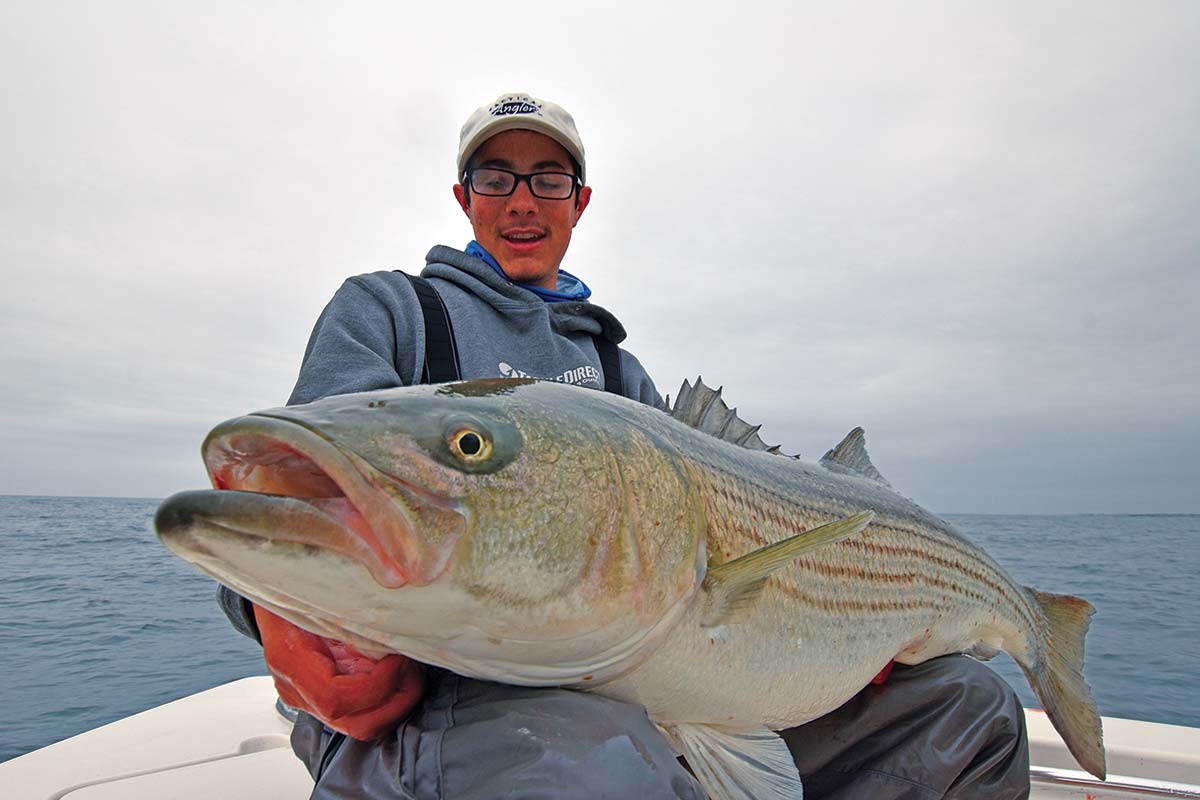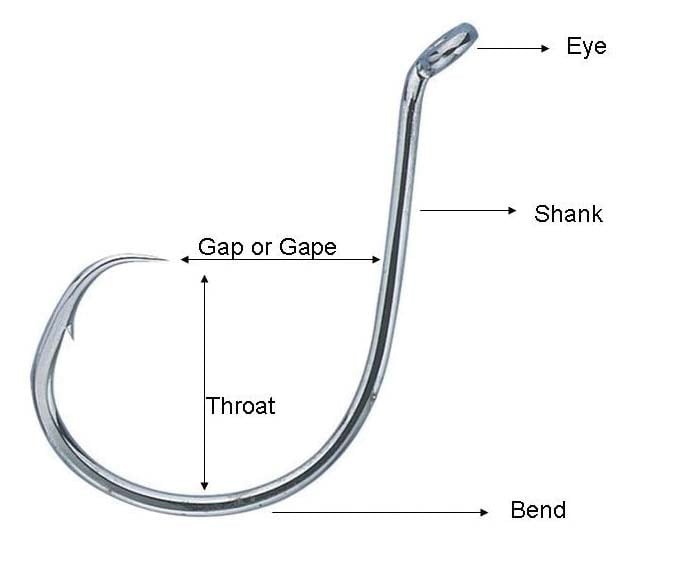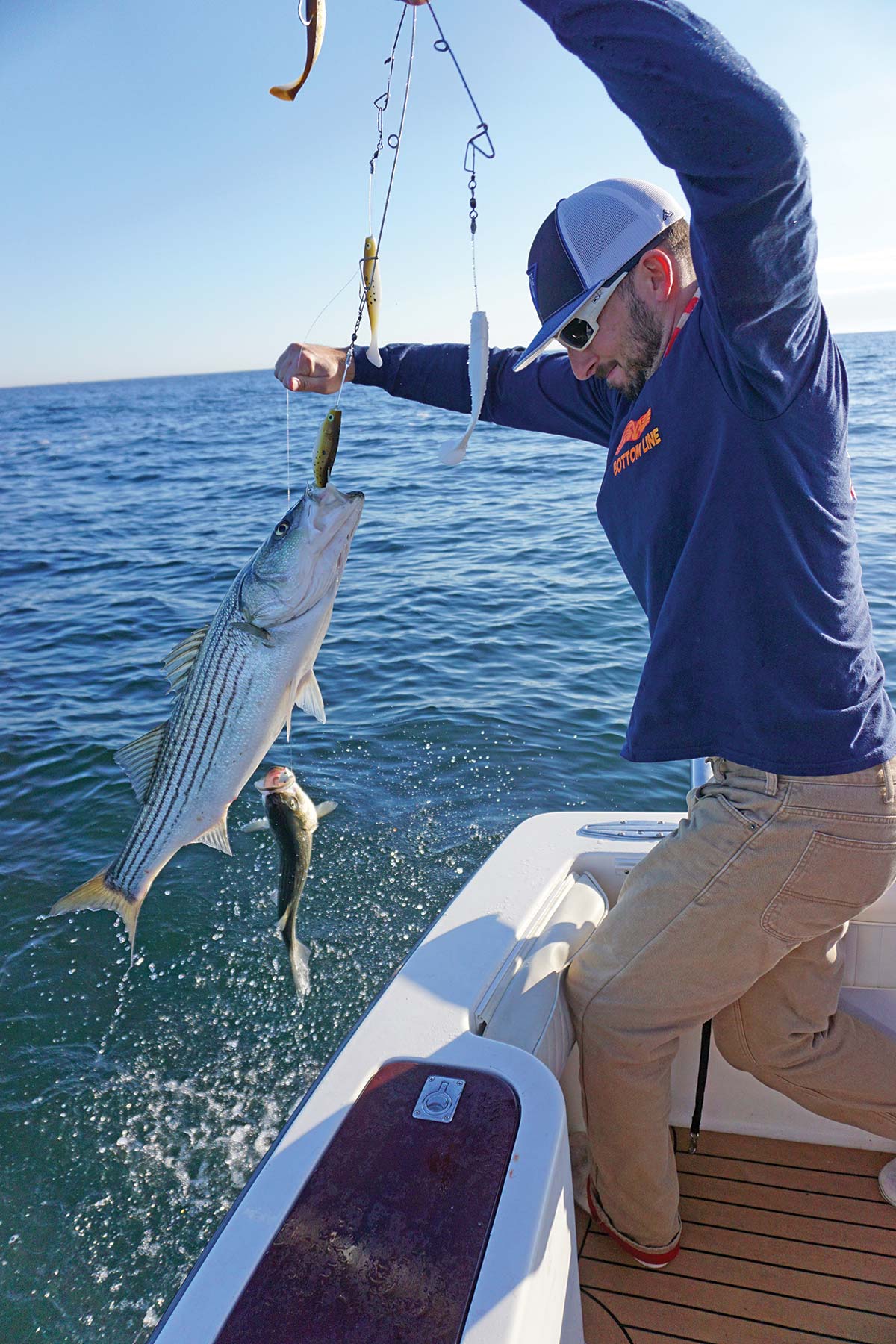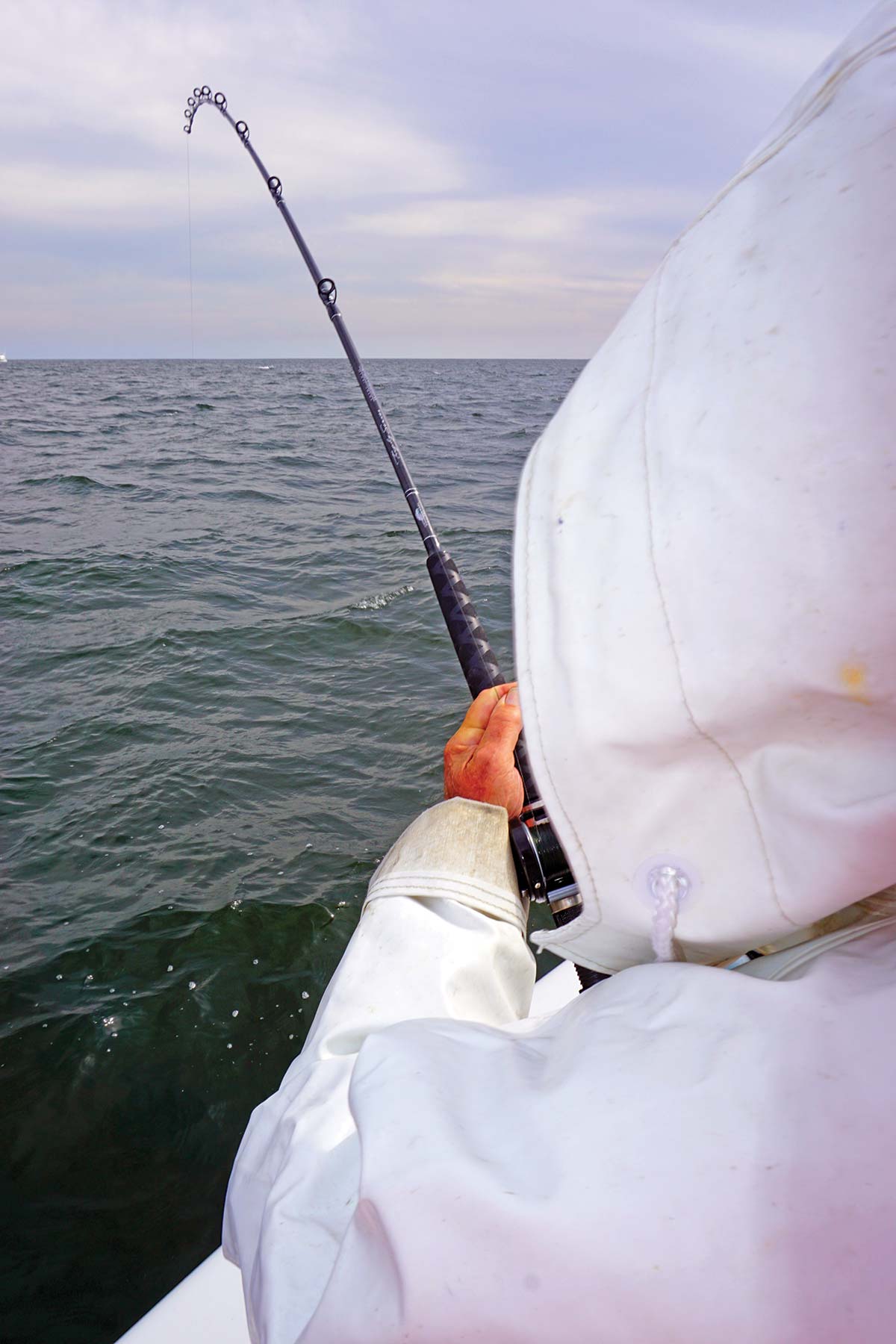
The fundamentals of hook selection and deployment in the new age of striper conservation.
My daughter Samantha was 9 when I first took her fishing for black drum. This was 13 years ago and I had already switched over to circle hooks when fishing clams at anchor for stripers and drum. But Sami’s first experience with circle hooks was her first experience in this fishery, so her learning curve was a bit flatter than most; in other words, I didn’t have the issue of teaching her “not” to set the hook on a bite.
For that particular spring fishery I use two conventional outfits set up with find-finder rigs off the stern of the boat, each with a glob of fresh-shucked surf clam impaled one time on a circle hook in the 9/0 range. Outfits are set in free spool with the clickers on, providing just enough tension to keep the line taut should one of these spring boomers pick up and run with a bait.
In the Great Bay area of New Jersey a mixed-size class of black drum enter the estuary in late April into early May to spawn. Not all of these “boomers” are of 60- to 80-pound class famous along the Delaware Bay, but more along the lines of “dinner” drum in the 10- to 20-pound class. Also on the spawn at this time are sizable smooth dogfish, 5- to 8-pound “sharks” for a wide-eyed 9-year-old.

When the clicker first began sounding on the starboard side outfit, Sami followed my pregame instructions perfectly, grabbing the noisy outfit from the rodholder and simply turning the handle to fight the fish. As I was freeing the circle hook from the mouth of her first of many doggies, a trickle of blood came from the shark’s lip. I could tell Sami was a bit put off, so after ensuring her that the fish was otherwise unharmed, I flattened all of the hook barbs.
“You won’t see any more blood, but you have to make sure you don’t give these fish any slack at all or you’ll lose them,” I instructed. For the next hour, my daughter went from rod to rod, the rod holder – affectionately ever after known as Rodney – hooking each subsequent fish, capably fought by Sami, one after another. That was until our fish of the day hit the deck of the boat, a solid 15-pound drum hooked squarely in the jaw after picking up the clam bait and making a run. As that drum thumped on the cockpit floor, I looked at my daughter with pride and asked what she wanted to do with her catch.
“I want to eat it,” she said then, though today she disputes this account.
Clear Your Throat
Honestly, I think everything you ever needed to know about successfully hooking up using circle hooks is included in the opening paragraphs. Those of us who’ve been around long enough to think we know more than we actually do, well, we were taught differently. Bow to the fish, set the hook, cross his eyes; the big swing to drive the sharp point of a J hook continues on numerous coastal fisheries, but when it comes to striped bass as of 2021, there’s a bit of a relearning process.

The inward facing hook point of the circle hook is designed to pull from a fish’s interior as it “turns and burns” with your bait, catching ever so slightly at the corner of its mouth. Because the circle hook is designed to catch fish in the lip area as opposed to deep in soft tissue or vital organs, it typically reduces the mortality rate. In fact, studies on striped bass catch and release show the mortality rate on stripers released with a circle hook is anywhere from 1 to 6 percent, whereas standard J hook mortality rate is anywhere from 9 to 18 percent. Given that statistics show nearly 50 percent of the entire striped bass harvest from in a single year comes from the bass that die after being released, the spirit and intent of the circle mandate is clear.
For those deadsticking softer baits like fresh clam at anchor, the circle hook and rod holder combination has been an easy and effective transition when fishing for black drum and striped bass alike. However, fishing live baits like menhaden or wriggling eels may take a little more practice; I know it did for this “old dog” as I began making the switch to circles for stripers in the early to mid-2000s. While fishing by boat with clam belly turned out to be a no-brainer, I was immediately having trouble getting solid hookups with circle hooks when using big baits. I contacted Jeff Pierce, who at the time had been working at Mustad. It was Pierce, who now works for Scientific Anglers, who first explained to me the importance of keeping the “gap” and “throat” of the hook free and clear of any bait blockage.
The hook’s gap or gape is the area between the hook point and the shaft; below that line to the bend in the hook is the throat, which I tend to think of as a bucket. That inward facing point needs to be completely exposed to hit its mark; but for the circle to really function as designed, that “bucket” needs to be as empty as possible, free from any fouling. I believe this is the number one issue experienced by anglers who have had problems with circle hooks, and it’s easy to remedy even if this may sound tedious.
Easy Bridling
I turned the corner in my personal transition to circle hooks when I first began to bridle my live baits. It started with using rubber bands or twist ties, poking a hole from one side of a bunker to the other, threading the rubber or twisty through the hole, and then tying to the very bottom of the hook. What this does of course is leave the gap/gape and throat nearly 100-percent free of any entanglement, as a live menhaden swims freely with the circle hook attached. Easier still was when Long Island’s Dean Delledonne gave me a handful of bait bridles that he created a number of years back which he asked me to try. Today, I keep packages of his 3D Fishing Products’ Ultimate Bait Bridle (ultimatefishingfloat.info) wherever I keep my circle hooks and fish-finder rigs.
This is an extremely quick and easy way of keeping the gap free and literally takes seconds to rig a bait. Grab a live bunker, open the clasp of the Ultimate Bait Bridle (it’s basically a snap) and run the point from one eye socket out the other, and then close. Take the point of the hook and impale through the rubber material of the bridle and you’re done. It works well if you’re rigging live baits through the snout, as well as forward of the dorsal fin of your bait. It works equally well with chunk baits too, though Dean personally recommends the Offshore size for chunking in the surf.
“But what about snag and drop?” One of the biggest questions heard during the circle hook transition from 2020 to 2021, what about those snag rigs used for snatching baits and freespooling to stripers. Well, that’s dead folks. IGFA would never allow it in terms of registering a potential record, and Virginia has in fact held a longtime regulation against snagging of any baits. Suffice to say, the fact that other Mid-Atlantic and Northeast states at least still allow you to snag baits at this point is still a point in our favor.
When fishing bunker schools, have two outfits ready to deploy, one a spinning outfit with 30- to 50-pound braid to a 40-pound leader with a snap. That can be used for either the snag rig or adding lures (pencils, metal-lips, swim shads) to fish around the schools. The other outfit is a conventional with 20- to 25-pound mono (I prefer that bit of stretch, and lessens the tangle fiasco when two livelined bunker meet) through a fish-finder rig to the leadered circle. Now you’re ready to snag and redeploy.
Snag those baits, stick them in the livewell; better yet, learn to throw a cast net and your bait duties are done for the day in a matter of minutes.
Tournament sailfish guys in the South Atlantic have been dealing with these circle hook rigging issues for years. Floridians heading off in search of sails typically start by throwing a cast net on pods of bait which are deposited into the livewell before heading to the fishing grounds. With the advent of new circle hook requirements, the crew will typically bridle all the baits before going into the well so that each morsel is ready to deploy once on the grounds. The Quick Rig system of Fort Lauderdale was one of the early rigging systems I saw, one which required a special hand tool and specialized steel clips. As 3D Fishing Products proves, some new tricks do make it easier on us old dogs.
Yes, it’s still an extra step in the bait rigging process, I get it. But in terms of rigging large, solid bait chunks or liveies with circle hooks, it’s the easiest way towards success.
One issue that the bridle won’t rectify is lively baits riding up the shaft and getting fouled on the hook. VMC has been one of the first hook manufacturers to jump into the problem fray with stripers by releasing their new B-LOK series; it features a piece of heavy fluorocarbon glued into position on the hook shank just above the bend. The tips of the fluoro point towards the bend, keeping live menhaden or eels from riding up the hook shank (though truth be told, the folks at VMC have a killer hook concept for rigging bloodworms and clams as well by reversing the direction of the fluoro, hint hint).
Gauging Hook Selection
I hate to turn fishing for striped bass into rocket science, but for those just now making the switch from J hooks to circles because of the new mandate I do think you’ll need to step back and think of the fundamentals. When you consider basic hook anatomy and the need to keep the throat open, choosing a circle hook means understanding the bait and the application du jour. The gauge of the wire for example; if you’re fishing with live eels or worms a thinner gauge is probably the better plan, and a hook size in the 5/0 class. Bigger eels? Go up in class, 7/0 to 9/0. And in terms of live bunker or chunks, most certainly thicker gauge and larger sizes, 9/0 and up.
In addition to the size of the hook and the gauge of the wire, you may find it’s more effective to match your line accordingly. If you’re using smaller baits and lighter hooks, you may want to lighten your leader selection and go with a lighter drag. And in terms of the benefits of a braided main line, because the circle hook function by design is to hook a striper in the mouth as it’s “turning and burning” with your bait, I prefer to liveline bunker using heavier hooks and 20- to 25-pound mono because that little extra stretch provides a little room for comfort.

When settling into a hook decision, there are a few things to keep in mind though. First, the hook manufacturers thus far have never settled on a size standard. It was the Atlantic States Marine Fisheries Commission (ASMFC) that required the new circle hook mandate for striper anglers using natural baits, yet as early as 2003 the ASMFC recognized this particular issue in a published report called Circle Hook Definition and Research Issues.
Hook size measuring convention varies widely between manufacturers and even between hooks made by individual manufacturers. A 5/0 hook from one company may be the same size as an 8/0 hook from another, which can be very confusing to anglers. However, there are parts of the hook that could be used to develop standards (gap width -the distance between the point and the shank; throat – the distance from the tip of the point to the bottom of the hook bend; etc.).
Laying five different 7/0 size hooks from five different manufacturers along a tape measure for scale shows the varied differences between the hook styles, especially in terms of the size of the gap between hook point and shank. Something to keep in mind is that the wider the gap the inherently weaker the hook. That’s not to say that choosing too wide a gapped hook will result in hook breakage and fish loss, but it’s something to keep in mind in the whole equation.
Personally, I have found circle hooks very effective when livelining eels. While on the drift with a live eel hooked through the bottom of the jaw and out the top, I’ll fish with my thumb on the open spool just as I’ve always done. When I feel that nervous bait or feel the pick up, I’ll let my thumb off and give it a couple of seconds to determine if the striper is running. Lock it up but keep the rod tip down, and then start reeling. As the rod tip hits the water, I’ll slowly raise the rod and reel until I feel that the fish is on the hook; then it’s just a matter of fighting the fish. Slowly lift and reel, they’re four words that you should expect to recite in your head over and over again as you transition to the circle hook.
We all lose fish from time to time, no matter the gear type or target species; every dog has his day. And while this may be a lot to digest for those now coming to the circle hook mandate with a little kicking and screaming, just try to remember these four key tips to ensuring better hookups this season
- Match your gear to the bait selection and application.
- Keep the hook gape/gap and throat clear.
- Let “Rodney” hook the fish.
- Slowly lift and reel.
I will say this, which is something that I first instilled in my daughter on those first fish she caught with a circle hook; with a J hook impaled deep in the gut of a good striper and 3 feet of 60-pound leader hanging out the maw, there wasn’t too much nuance to fighting a fish. Let’s be honest, you weren’t losing that fish unless you had a bad knot or a gear malfunction. But a hookset in a striper’s jaw will wear a hole in the cartilage during the fight. Slack in the line during a striper battle in that situation will allow the fish to throw the hook. Sami learned that the hard way with the bent barb, so keep your line taut during the fight and don’t give him any slack.
But first, just remember, let Rodney (rod holder) hook your fish, then slowly lift and reel.





